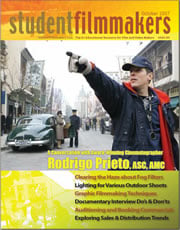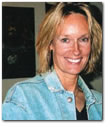Check out this article in the print edition of StudentFilmmakers Magazine, October 2007. Click here to get a copy and to subscribe >>
 A Conversation with Award-Winning Cinematographer Rodrigo Prieto, ASC, AMC A Conversation with Award-Winning Cinematographer Rodrigo Prieto, ASC, AMC
by Jacqueline B. Frost
What do you think of digital technology such as the HD cameras available today?
Rodrigo Prieto, ASC, AMC: I did shoot �Ten Tiny Love Stories� in HD. We used the Sony F-900, but it was simple monologs to camera, so I didn�t put it through the works. Then I tested a Viper camera for �Babel� for the Japanese story. For this new movie I may use HD for a portion of the movie. If you�re going for a certain look, it becomes a creative decision. I do find the technologies are getting better.
Do you think it�s harder to light digital?
Rodrigo Prieto, ASC, AMC: Yes, it has been case, but some of the newer technologies are trying to address that. I found that when I did the �Ten Tiny Love Stories,� we had windows in the backgrounds, and I had to worry about the highlights. I didn�t like how they were clipping, so all this hype about it being easier and cheaper, and you don�t need lighting, it�s ridiculous. So I experienced it first hand in that case. It can be more complicated to light, but in low light, it does have its applications.
Do you think it�s better to stay away from contrast in those situations, to stay softer with digital?
Rodrigo Prieto, ASC, AMC: Just in terms of highlights, that�s where it gets complicated. That�s what you have to watch out for. It�s maybe a little like when you are shooting reversal or cross processing or bleach by pass. That�s where you have to be conscious of highlights, like when I was shooting �Amores Perros� or �21 Grams.� But it has its applications. Maybe you are going for clipped highlights in some scenes, so why not?
Like your blown out windows, it became kind of a stylistic thing?
Rodrigo Prieto, ASC, AMC: [Laughs] Yeah, you know there is a difference. It�s the way highlights blow out on film. It�s the curve, it�s that shoulder, overexposure on film becomes soft, and I like that. I sometimes use that, the softness of overexposure. But on digital, it�s a hard edge, and I don�t like that, usually, unless you go for that for an aesthetic decision.
Are you worried about film?
Rodrigo Prieto, ASC, AMC: No, not worried, not now. I used to be earlier. I heard all this hype and tested these first cameras. I did the movie with the F-900. And they were hailing it like, this is it. I could see it was certainly not at all the quality of film, let alone the look. It didn�t have the resolution or color depth, no matter what they say. It just didn�t have the same range of film in terms of latitude or color, so what� so great about this? And all these cables and electronic inductions, a lot of problems. I just couldn�t figure out what people loved about it. Maybe the fact that you can keep rolling, and advantages like that, which have its applications. But aesthetically, I didn�t see it. But now, I�m looking at the new cameras that do nearly 4k resolution like the Dalsa, or the Red, although I�m not totally convinced about the Red in terms of latitude. I could still see the highlights clipping, but I was very impressed by the tests I saw of the Dalsa, which really had a high contrast situation, and it held up beautifully. It still had two or three issues, but it seems like we are finally approaching a situation where digital cameras will have a quality that is close to film.
On my new film, �State of Play,� I�m thinking of using digital on some scenes because of the lack of grain. Digital becomes a different palette which enhances the possibilities of different textures on a movie. I will use film for some scenes for its characteristics and its grain, and I will use digital for its look and its lack of grain. It�s adding to our possibilities. And I�m also learning a lot. It�s like being in film school again still trying to understand all this technology. This new language I didn�t have to deal with before. It�s interesting, exciting.
This article may not be reprinted in print or internet publications without express permission of StudentFilmmakers.com. Photos may not be copied or reproduced.
Check out this article in the October 2007 print edition of StudentFilmmakers magazine, page 14. Click here to get a copy of the October 2007 Edition, so you can read and enjoy all of the excellent articles inside.
About the Author:
 Jacqueline B. Frost is a Los Angeles-based cinematographer and author. She teaches cinematography and advanced film production at California State University, Fullerton, as well as a course through the UCLA Extension entitled, �Cinematography for Directors.� Jacqueline has shot numerous short films, independent feature films and documentaries that have screened in film festivals around the world. She has also taken on the role of producer, director, and editor on many projects. Jacqueline B. Frost is a Los Angeles-based cinematographer and author. She teaches cinematography and advanced film production at California State University, Fullerton, as well as a course through the UCLA Extension entitled, �Cinematography for Directors.� Jacqueline has shot numerous short films, independent feature films and documentaries that have screened in film festivals around the world. She has also taken on the role of producer, director, and editor on many projects.
Resources:
About StudentFilmmakers Magazine and StudentFilmmakers.com >>
Join the Film and Digital Networking Community >>
Post Your Films, Videos, Reels, and Trailers >>
Discuss Motion Picture Techniques in the Online Industry Forums >>
Get the StudentFilmmakers.com E-Newsletter >>
StudentFilmmakers magazine would like to hear from you!
Click here to share your comments and feedback about the magazine, monthly editions, your favorite articles, and your favorite topics.
We always welcome and appreciate your Reader Comments. View them here, and send yours to the editorial team today!
|

 Jacqueline B. Frost is a Los Angeles-based cinematographer and author. She teaches cinematography and advanced film production at California State University, Fullerton, as well as a course through the UCLA Extension entitled, �Cinematography for Directors.� Jacqueline has shot numerous short films, independent feature films and documentaries that have screened in film festivals around the world. She has also taken on the role of producer, director, and editor on many projects.
Jacqueline B. Frost is a Los Angeles-based cinematographer and author. She teaches cinematography and advanced film production at California State University, Fullerton, as well as a course through the UCLA Extension entitled, �Cinematography for Directors.� Jacqueline has shot numerous short films, independent feature films and documentaries that have screened in film festivals around the world. She has also taken on the role of producer, director, and editor on many projects.